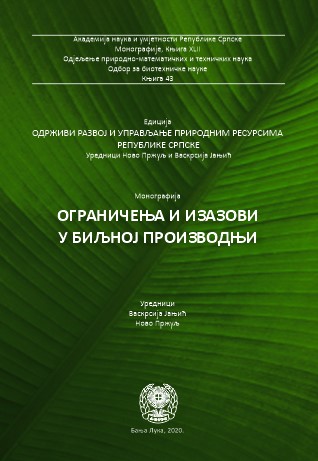The global status and ecological consequences of cultivation of genetically modified plants
DOI:
https://doi.org/10.7251/EORU2003485JKeywords:
Genetically modified plants, herbicides, resistance, growing area, environmental consequences, soya, corn, cotton and rapeAbstract
The latest accomplishments in molecular genetics, biochemistry and physiology enabled creation of genetically modified organisms (GMO) with changed properties. A genetically modified organism is an organism whose genetic material has been changed in a way that does not happen in nature by crossbreeding and/or recombining, while genetically modified food is such food that is derived from or that contains the ingredients from genetically modified organisms. The first generation of genetically modified plants is plants tolerant to herbicides and resistant to insects. Genetically modified plants tolerant to herbicides raised interest by various researchers who agree that the only ones who benefit from these plants are farmers, producers of herbicides and seeds, and not the consumers of final products. Today a big number of genetically modified cultivated plants are being created (corn, soya, potato, cotton, rape, tomato, sugar beet, wheat, rice, carnation, pumpkin, tobacco, chicory, flax, melon, sugar cane, papaya and other plants. Only 4 agricultural plants are cultivated on large surfaces: soya, corn, cotton and rape. Since the very beginning of cultivation of genetically modified plants and production of food from genetically modified organisms, scientific and other debates have been going on regarding the safety of use, health-related consequences for the people and the environment and the necessity of marking the food obtained from genetically modified organisms. The risks related to cultivation and the use of food from genetically modified organisms are not yet fully known or clarified in detail. The main risks common for all genetically modified organisms relate to the fact that the process of their formation is accompanied with the mutation by inserting the genes homologous and heterologous evolution organisms which creates a possibility for genome changes to continue later during the period of commercial use. Such occurrences may cause changes both to the environment and the living organisms. Transfer of genes from cultivated plants to wild relatives is an already present problem. Only 11 of 60 cultivated varieties of plants in the world do not have wild relatives, while for 12 of 13 leading cultivated plant varieties natural hybridization with wild relatives has been proved. This paper discusses the various problems that exist in the creation and cultivation of genetically modified plants resistant to herbicide. The basic genetic modification of plants resistant to the most important herbicides is described. The advantages, such as easier and cheaper weed control, more effective weed control that cannot be effectively suppressed with herbicides in conventional production, greater flexibility in the application of herbicides, the ability to suppress parasitic weeds, less risk the environment and the possibility of alternative production systems, that evolves from the cultivation of genetically modified plants resistant to herbicides are also pointed out. In this paper some of the risks related to the use of genetically modified crops resistant to herbicides are discussed: the emergence of applied gene mutation,which creates opportunities to change the genome of teaching and later, an additional problem substances and preparations which are standard throughout the process of genetic transformation, gene transfer to wild relatives and weeds, genetically modified plants resistant to herbicide as wild plants in the following crops, increasing the risk of damage to non-target plants herbicide broad spectrum of activity, the potential impact on biodiversity and changes of weed flora.
